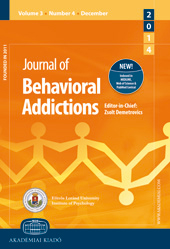Characteristics and treatment response of self-identified problematic Internet users in a behavioral addiction outpatient clinic
Characteristics and treatment response of self-identified problematic Internet users in a behavioral addiction outpatient clinic
Author(s): Gabriel Thorens, Sophia Achab, Joël Billieux, Yasser Khazaal, Riaz Khan, Edward Pivin, Vishal Gupta, Daniel ZullinoSubject(s): Psychology, Behaviorism, Substance abuse and addiction, ICT Information and Communications Technologies
Published by: Akadémiai Kiadó
Keywords: Internet; problematic; usage; addiction; gaming;
Summary/Abstract: Controversies remain about the validity of the diagnosis of problematic Internet use. This might be due in part to the lack of longitudinal naturalistic studies that have followed a cohort of patients who self-identify as having Internet-related problems. Methods: This retrospective study included 57 patients who consulted the Geneva Addiction Outpatient Clinic from January 1, 2007, to January 1, 2010. Patients underwent an initial clinical psychiatric evaluation that included collection of data on socio-demographics, method of referral, specific Internet usage, psychiatric diagnosis, and Internet Addiction Test (IAT) and Clinical Global Impression Scale (CGI) scores. Treatment consisted of individual psychotherapeutic sessions. Results: Of these patients, 98% were male and 37% were 18 years or younger. Most patients were online gamers (46% playing massively multiplayer online role-playing games). The mean IAT score was 52.9 (range 20–90). Sixty-eight percent of patients had a co-morbid psychiatric diagnosis, with social phobia being the most prevalent (17.8%). Patients who remained in treatment (dropout rate 24%) showed an overall improvement of symptoms: 38.6% showed significant or average improvement on their CGI score, 26.3% showed minimal improvement, and 14% showed no change. Conclusions: Our results support the hypothesis that there are specific types of Internet use, with online gaming mainly affecting young male patients. As Internet addiction is not yet an official diagnosis, better instruments are needed to screen patients and to avoid false-negative and false-positive diagnoses. Successful care should integrate the treatment of co-morbid symptoms and involve families and relatives in the therapeutic process.
Journal: Journal of Behavioral Addictions
- Issue Year: 3/2014
- Issue No: 1
- Page Range: 78-81
- Page Count: 4
- Language: English

